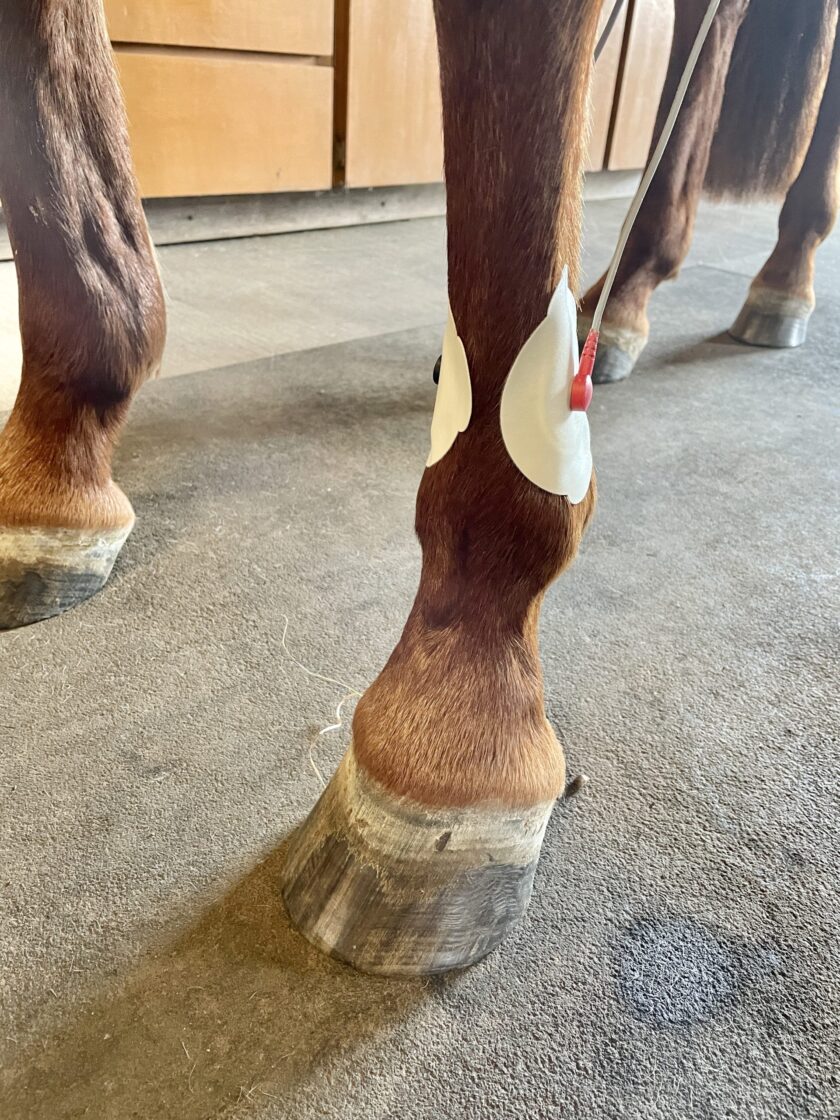A Look at Iontophoresis for Horses
This age-old therapy uses subtle electrical currents to help with various ailments and injuries.
Iontophoresis (pronounced ion-to-for-ree-suss) is a fancy way to say “to transfer drugs through the skin using electrical current.” Iontophoresis also means ion transfer using current to repel water-soluble medication into subcutaneous tissue. A limited amount of drugs are considered phoresable.
The current requirement to treat horses with iontophoresis is relative to time and comfort. The industry standard is to use an instrument specifically designed for phoresing, which delivers dosages in 10 to 20 minutes per polarity. Steroid medications have a negative polarity, and antibiotics are positive and are put on special pads called drug delivery electrodes. The current ranges offered with phoresors are .05 to 4 mA (milliamperes). Most horses are comfortable during treatments at 3 or 4 milliamps; the most sensitive types need to be phoresed at 2 mA. A 4 mA transfer is completed in 10 minutes; at 2 mA, it will take 14 minutes.
Horses will feel a slight tingling sensation, and it takes a few minutes to get accustomed to it the first time they are phoresed. The magic of using phoresor is that if you change the current during treatment to find what is most comfortable for your horse, the instrument automatically recalculates the time required to make the transfer and turns off when it’s done. Phoresor units also have resistance monitoring, so if the drug-delivery pad falls off or you have not applied it correctly, a reject light comes on. However, most horses will not tolerate a Phoresor due to the spike in current at the onset. So, we use a different device to keep horses comfortable with the treatment.
Horses Benefit from Iontophoresis
There is limited information about equine use, but enough to make it a viable option, particularly if you are looking for alternatives to injections. In the past, resistance to phoresing was partly due to equipment costs and time. Very few veterinarians rent or loan out the equipment as Dr. Letich (1) does.
The Pros are:
- Non Invasive.
- No infections as needle injection can.
- Can produce a more diffused delivery of medications.
- Trace the amount of medication compared to the amount injected with the needle.
- No tissue damage.
The Best Results reported are for Horses with:
- Splints
- Degenerative Joint Disease
- Ring Bone
- Check and Suspensory Ligament problems
- Tendon injuries such as small tears
- Surface musculoskeletal Injuries
If familiar with treating horses with microcurrent therapy, it is an easy transition to phoresing.
Horses responding well to microcurrent have greater potential to benefit from iontophoresis (i.e., as an alternative to joint injections). The cocktail of choice, or “Horse Cocktail,” introduced by a veterinarian in Vancouver, WA, seems helpful for all the conditions mentioned above.
Good results are reported from a variety of dosages. Technically, Depo Medrol is not considered to be a phoresable medication. Still, the doctor thinks it might contribute to some time-release action, making the medications stay in the horse’s tissue longer. However, with the high cost of Depo Medrol, it’s rarely used by us phoresing horses.
Horse Cocktail
It is a mixture of 4mg/ml or 10mg/ml of Dexamethasone, 40mg/ml of Depo Medrol, both steroids and Sarapin (pitcher plant), a natural pain reliever. My customers report that the exact mixture of the cocktail does not seem critical.
Here’s the most common mixture used on a 4cc fill pad.
- 2.0 cc of Dexamethasone (Negative) 4mg/ml
- 2.0 cc of Sarapin (Positive) aka P-Bloc
You must always fill the pad to capacity, which can be achieved by filling the balance of a pad with saline solution (negative). Common eye contact solution with no additives is handy to have on hand for this purpose.
My results have been very satisfying when treating people and horses with iontophoresis. I used the Horse Cocktail for my Carpal Tunnel and Tendinitis (along with microcurrent and Myofascial Release therapy), which reduced my usual downtime. I treated two of our horses, one with a suspensory ligament injury and the other with chronic windpuffs that became more aggravated. I do not profess to be an expert on this subject. However, I listen to customers’ needs and learn of their successful outcomes.
Addition of Sarapin
One of the remarkable differences from the past with mostly just dexamethasone used is the benefit from Sarapin. Sarapin is known for relieving neuromuscular pain as an injectable with immediate effects; sometimes, the pain relief lasts for days or weeks (4). This effect seems similar when phoresed. There are no known adverse side effects from using Sarapin.
As a veterinarian once said, “We don’t know if it was the first thing we did or the last thing, or was it the combination of all.” I know that sound horses are important to all of us, and if phoresing can make them more comfortable and safely help them, why not?
* 10mg/ml Dexamethasone was used in a study conducted at OSU (ref: 2)
References
- Article “Update: New Weapons for the Lameness Battle” by Sue M. Copeland (April 02 Practical Horsemen)
- 1999 International Symposium of Rehabilitation and Physical Therapy in Veterinary Medicine. The study presented “Iontophoresis of Dexamethasone into the Tarsocrural Joint of Horses” by Andris J. Kaneps, Amorrie Craig, Karen Walker College of the Veterinary Medicine, Oregon State University
- “The New Equine Sports Therapy Book” by Mimi Porter; refer to Chapter 6 Electrical Stimulation, pgs 104- 124
- “Equine Drugs and Vaccines” by Eleanor M. Kellon V.M.D. 2004 Matrix Therapy Products Corp.
Get Started Today
Our Equine Iontophoresis Kit has the device and supplies to get started.
Your veterinarian will need to order the medications. Please see the article on Sarapin, as it is now only available through three US compounding pharmacies.
Copyright © 2004, Matrix Therapy Products Corp. All rights reserved. Reproduction in whole or in part without written permission is prohibited. Updated 2023

